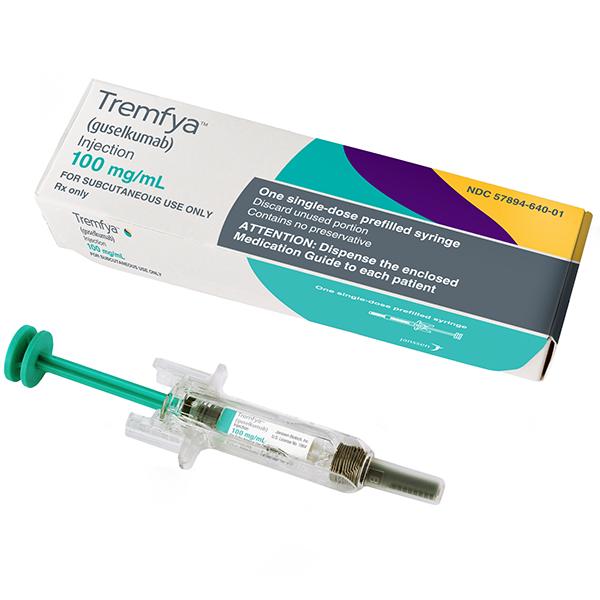Tremfya Dosage
Generic name: GUSELKUMAB 200mg in 20mL
Dosage form: injection
Drug class: Interleukin inhibitors
Medically reviewed by Drugs.com. Last updated on Mar 25, 2025.
Recommended Evaluations and Immunizations Prior to Treatment Initiation
- Evaluate patients for tuberculosis (TB) infection prior to initiating treatment with TREMFYA .
- For the treatment of Crohn’s disease or ulcerative colitis, obtain liver enzymes and bilirubin levels prior to initiating treatment with TREMFYA .
- Complete all age-appropriate vaccinations according to current immunization guidelines .
Recommended Dosage for Plaque Psoriasis
TREMFYA is administered by subcutaneous injection. The recommended dosage is 100 mg at Week 0, Week 4, and every 8 weeks thereafter.
Recommended Dosage for Psoriatic Arthritis
TREMFYA is administered by subcutaneous injection. The recommended dosage is 100 mg at Week 0, Week 4, and every 8 weeks thereafter.
TREMFYA may be administered alone or in combination with a conventional disease-modifying antirheumatic drug (e.g., methotrexate).
Recommended Dosage for Ulcerative Colitis
Induction:
The recommended induction dosage of TREMFYA is 200 mg administered by intravenous infusion over at least one hour at Week 0, Week 4, and Week 8 .
Maintenance:
The recommended maintenance dosage of TREMFYA is:
- 100 mg administered by subcutaneous injection at Week 16, and every 8 weeks thereafter, or
- 200 mg administered by subcutaneous injection at Week 12, and every 4 weeks thereafter.
Use the lowest effective recommended dosage to maintain therapeutic response.
Recommended Dosage for Crohn’s Disease
Induction:
The recommended induction dosage of TREMFYA is:
- 200 mg administered by intravenous infusion over at least one hour at Week 0, Week 4, and Week 8 or
- 400 mg administered by subcutaneous injection (given as two consecutive injections of 200 mg each) at Week 0, Week 4, and Week 8.
Maintenance:
The recommended maintenance dosage of TREMFYA is:
- 100 mg administered by subcutaneous injection at Week 16, and every 8 weeks thereafter, or
- 200 mg administered by subcutaneous injection at Week 12, and every 4 weeks thereafter.
Use the lowest effective recommended dosage to maintain therapeutic response.
Preparation and Administration Instructions for Subcutaneous Injection
TREMFYA is available for subcutaneous use in the following presentations: prefilled pen (TREMFYA PEN), One-Press injector, and prefilled syringes .
- Administer TREMFYA subcutaneously. Each prefilled pen, One-Press injector, or prefilled syringe is for one time use in one patient only. Instruct patients to inject the full amount: 100 mg or 200 mg of TREMFYA (1 mL or 2 mL, respectively).
- TREMFYA is intended for use under the guidance and supervision of a healthcare professional. TREMFYA may be administered by a healthcare professional, or a patient/caregiver after proper training on correct subcutaneous injection technique.
- Before injection, remove TREMFYA from the refrigerator and allow to reach room temperature (30 minutes) without removing the needle cap.
- Inject into the front of the thighs, the lower abdomen except for the 2 inches around the navel, or the back of the upper arms (healthcare professional or caregiver only).
- Do not inject TREMFYA into areas where the skin is tender, bruised, red, hard, thick, scaly, or affected by psoriasis.
- The TREMFYA Instructions for Use contains more detailed patient instructions on the preparation and administration of TREMFYA .
- If a dose is missed, administer the dose as soon as possible. Thereafter, resume dosing at the regular scheduled time.
- Inspect TREMFYA visually for particulate matter and discoloration prior to administration. TREMFYA is a clear and colorless to light yellow solution that may contain small translucent particles. Do not use if the liquid contains large particles, is discolored or cloudy. TREMFYA does not contain preservatives; therefore, discard any unused product remaining in the prefilled pen, One-Press injector, or prefilled syringe.
Preparation and Administration Instructions for Intravenous Infusion (Ulcerative Colitis and Crohn's Disease)
Preparation Instructions:
- Withdraw and then discard 20 mL of the 0.9% Sodium Chloride Injection from the 250 mL infusion bag which is equal to the volume of TREMFYA to be added.
- Withdraw 20 mL of TREMFYA from the vial and add it to the 250 mL intravenous infusion bag of 0.9% Sodium Chloride Injection for a final concentration of 0.8 mg/mL. Gently mix the diluted solution. Discard the vial with any remaining solution.
- Visually inspect the diluted solution for particulate matter and discoloration before infusion. Infuse the diluted solution over a period of at least one hour.
- Use only an infusion set with an in-line, sterile, non-pyrogenic, low protein binding filter (pore size 0.2 micrometer).
- Do not infuse TREMFYA concomitantly in the same intravenous line with other medicinal products.
- Dispose any unused medicinal product in accordance with local requirements.
Administration Instructions:
- TREMFYA solution for intravenous infusion must be diluted, prepared, and infused by a healthcare professional using aseptic technique. TREMFYA does not contain preservatives. Each vial is for one time use in one patient only.
- Inspect TREMFYA visually for particulate matter and discoloration prior to administration. TREMFYA is a clear and colorless to light yellow solution that may contain small translucent particles. Do not use if the liquid contains large particles, is discolored, or is cloudy.
Storage of Diluted Solution:
- The diluted infusion solution may be kept at room temperature up to 25°C (77°F) for up to 10 hours. Storage time at room temperature begins once the diluted solution has been prepared. The infusion should be completed within 10 hours after the dilution in the infusion bag.
- Do not freeze.
- Discard any unused portion of the infusion solution.
Frequently asked questions
- What are monoclonal antibodies?
- How long does it take for Tremfya to work?
- How and where do you inject Tremfya?
- How long can Tremfya be out of the fridge?
- Can Tremfya cause cancer?
- Is Tremfya a biological?
- What are the new drugs for plaque psoriasis?
- What causes Plaque Psoriasis?
- How does Tremfya work?
More about Tremfya (guselkumab)
- Check interactions
- Compare alternatives
- Pricing & coupons
- Reviews (100)
- Drug images
- Side effects
- Patient tips
- During pregnancy
- FDA approval history
- Drug class: interleukin inhibitors
- Breastfeeding
- En español
Patient resources
Professional resources
Related treatment guides
Further information
Always consult your healthcare provider to ensure the information displayed on this page applies to your personal circumstances.


